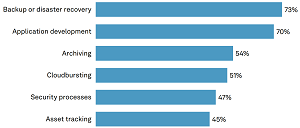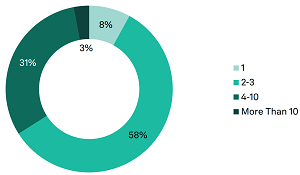News
Cisco Describes Hybrid Cloud 'New Normal,' Touts Cloud Operating Model for Success
"Hybrid cloud environments have become the new normal, particularly as consumers of IT services have become more empowered to make cloud choices that fit their needs," Cisco said in its new "2022 Global Hybrid Cloud Trends Report" while noting the adoption of a "cloud operating model" is key to success in that new normal.
The survey-based report backs up the "new normal" claim with data points indicating 82 percent of survey respondents have adopted hybrid cloud, while 47 percent of organizations use two or three public Infrastructure-as-a-Service (IaaS) clouds.
The report is based on a Cisco-commissioned web survey conducted by 451 Research that polled 2,500 global IT decision-makers and professionals in cloud computing, DevOps and enterprise networking roles.
"This hybrid approach enables organizations to achieve a more agile and scalable development environment (42 percent) and accelerate business agility and innovation (40 percent)," the report said. "In addition, as organizations consider the best venue for their workloads today and in the future, the use of multiple clouds has become a popular approach that allows organizations to select the best environment for their workloads, considering factors such as regional compliance, security and performance."
The following graphic illustrates the top workloads and applications that surveyed organizations are running in hybrid IT environments, showing answers to the question "Which of the following workloads or processes do you currently run in a hybrid IT environment?"
 [Click on image for larger view.] Organizations Use Hybrid IT Approach Across Myriad Workloads (source: Cisco).
[Click on image for larger view.] Organizations Use Hybrid IT Approach Across Myriad Workloads (source: Cisco).
Furthermore, "Most surveyed organizations (58 percent) use 2-3 public IaaS cloud providers for their workloads, with 31 percent of respondents using 4-10 public cloud providers. The organizations that use more than three cloud providers make use of alternative cloud providers outside of AWS, Azure and Google Cloud, which may include pure-play public cloud providers or cloud services offered as part of a broader portfolio (e.g., telcos)."
 [Click on image for larger view.] Most Organizations Use 2-3 Public Clouds (source: Cisco).
[Click on image for larger view.] Most Organizations Use 2-3 Public Clouds (source: Cisco).
Top challenges included: security (listed by 37 percent of respondents); operational complexity (33 percent); and cost containment (33 percent). Interestingly, the crippling skills shortage was barely mentioned at all, just in this passage about the security challenge: "These security concerns are likely exacerbated by a lack of skills and budget in many organizations, which can lead to a strategy that fails to protect data and workloads in cloud-native environments -- where development happens faster, and there is greater use of automation."
As far as thriving in the new normality of hybrid/multi-cloud environments and overcoming those challenges listed above, Cisco's DD Dasgupta said an organization's cloud adoption strategy is highly dependent on evolving to a cloud operating model.
"To me the most important takeaway is that these three challenges should not be viewed as discrete issues but as highly interrelated ones," he said in a May 25 blog post. "It will then be clear that the right solution will require establishing an enterprise-wide infrastructure strategy built on an evolution to a cloud operating model that accelerates the adoption of multi-cloud and their cloud-native agenda.
"A successful cloud operating model can deliver important benefits such as enabling IT to provide self-service access to infrastructure, the ability to leverage a cloud-native toolkit with innovations readily available in public clouds, and lowering operating costs by paying for resources and services only as they consume them. Cisco customers who have adopted a cloud operating model are further innovating and enhancing their IT operations with proven hybrid cloud use cases. Some of the best ones I've come across include:"
- business continuity and backup at lower operational costs by using public clouds for disaster recovery and offsite data storage
- leveraging cloud-native services including API-led management of hardware, software, containers, microservices, and service meshes to maximize their agility and flexibility
- predictable and cost-effective access to resources and capacity via a flexible consumption model -- whether it's on-prem or a public cloud service
In addition to the Cisco report's "new normal" conclusion that the need to balance security with business agility and access to cloud-based services is driving enterprises to multi-cloud deployments, other key findings as presented by Cisco include:
-
Customer challenges grow with multiple cloud use
- 37 percent of respondents see security concerns as a significant challenge to deploying to multiple clouds.
- 35 percent view increased operational complexity as a top challenge when using multiple clouds.
-
Building cloud-ready
- 58 percent of respondents are moving workloads between on- and off-premises environments weekly.
- 47 percent of CloudOps and DevOps respondents say that a "cloud first" mandate is the tipping point for changing development processes and tools.
-
Operating cloud-smart
- High deployment among respondents of emerging technologies, including AIOps (45 percent), infrastructure automation (41 percent), composable infrastructure (37 percent) and edge computing (41 percent).
- 57 percent in networking roles strongly agree that it is important for their DevOps team to be involved in developing their organization's network strategy.
- Cost management is the second highest concern (33 percent) in multi-cloud operations.
- 79 percent of respondents say that more than 51 percent of their workloads will run on different hardware across environments, which reinforces the need for a comprehensive toolset for managing workloads regardless of where they reside.
-
Accelerating cloud-native
- 91 percent in DevOps and CloudOps roles say their organization plans to refactor applications using cloud-native technology, or has already done so.
- 73 percent say security is their top concern for cloud-native use.
"When executed properly, hybrid cloud can enable organizations to improve security, performance, business agility and operational resilience," said part of the report's conclusion. "It's a capability that can offer support for a range of leading-edge technologies that accelerate developer efficiency while driving effectiveness of cloud operations. Organizations that we surveyed are advanced users of technology that rely on multiple clouds for delivery. What sets them apart is a more mature approach to cloud use and operations. They are looking to capitalize on agility, scale and technology advances, while expecting to leverage automation to manage costs and complexity."
About the Author
David Ramel is an editor and writer at Converge 360.